As a regular gymgoer, you probably know that protein is your best friend. Building muscle, recovering from hard training, and losing body fat require a pretty high protein intake. You may understandably assume that you have to eat plenty of meat and chicken to get there. But did you know you can get protein from vegetables, as well?
High-protein vegetables are packed with health-boosting nutrients, and you can combine them into satisfying, tasty meals to help you reach your goals. Whether you want to build muscle on a vegan diet or just add more plant-based protein, we’ve got the goods.
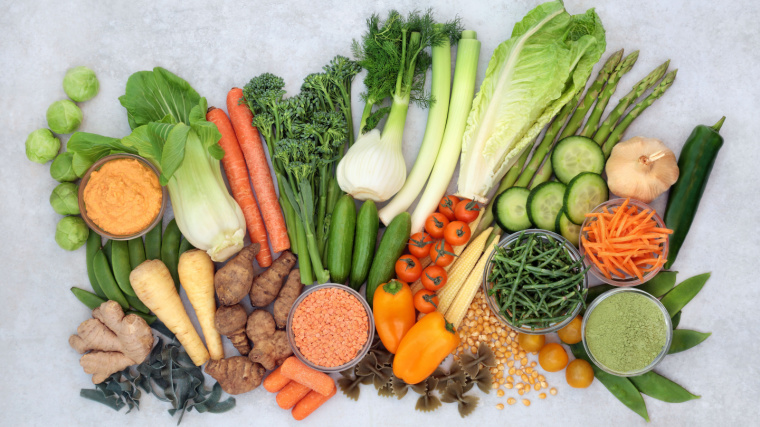
Here, you’ll learn explain the health benefits of protein and the most protein-rich veggies with all their nutritional information. We’ll also give you the details on calculating how much protein your body needs, depending on your goals. Healthy eating doesn’t have to be bland. So grab your shopping list and prepare to add these muscle-building veggies to your meal plan.
- Why You Need Protein
- Can You Get Adequate Protein From Vegetables?
- The Best High-Protein Vegetables
- How Much Protein Do You Need Daily?
- Frequently Asked Questions
Why You Need Protein
All your food consists of three macronutrients: protein, carbohydrates, and fat. Macronutrients combine to influence your health and provide energy. (1)
You need all three to fuel your health and workouts, but we’re here for muscle hypertrophy. When it comes to training, you need protein to help you build muscle mass and lose body fat. Eating a healthy diet packed with protein also influences your heart and bone health while boosting your immune system. Let’s break it down.
Helps Build Muscle Mass
Strength athletes are so fond of protein for a reason. This macronutrient helps build muscle mass when paired with resistance training. Here’s how it works.
Twenty amino acids, often called building blocks, make up muscle protein. Eleven amino acids are non-essential, and the remaining nine are essential amino acids. Your body cannot make them on its own, so you need to get them through your diet as complete protein sources. All twenty amino acids are necessary for hypertrophy. (2)
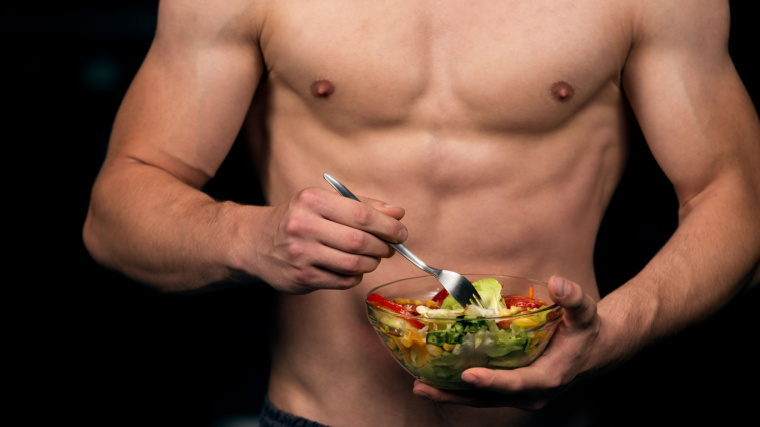
[Read More: The 12 Best Vegan Protein Powders]
When you’re in the gym lifting weights, you’re breaking down your muscle fibers. When you eat high-protein foods, you’re consuming dietary protein that helps repair and regenerate your muscle fibers after all those intense leg exercises on your favorite training day of the week. This process leads to muscle protein synthesis — or building muscle mass. (3)(4)
Resistance training is half of the equation, but your body needs protein to maximize your hard-earned gains.
Helps With Fat Loss
Whether you have a weight loss goal or you’re a bodybuilder on a weight cut, protein will help you with fat loss. Feeling full from your food can help you stay on track when you’re reducing your calories or portions. Protein is the most satiating macronutrient, so packing your meals with it can help you feel full between meals. (5)
Eating a high-protein diet also increases thermogenesis, meaning your body has to work harder to digest your food, slightly increasing your total daily energy expenditure (TDEE). Complete protein sources may have a higher thermic effect, increasing your TDEE even more. (5)(6)
[Read More: 20 High-Fiber Foods to Support Digestion]
Lastly, a high-protein diet and resistance training during weight loss can help your body preserve lean muscle mass. Some people can theoretically lose weight by reducing their calories or portions, but they may also lose muscle. Keeping your protein high and lifting weights is the key to maintaining muscle mass while losing body fat. (5)
Improves Heart Health
Athletes need a strong heart for tough HIIT workouts — AKA, high-intensity interval training sessions. Healthy eating and regular exercise are fundamental to strong cardiovascular health. Getting enough protein can help lower your risk of high blood pressure, high cholesterol, and heart disease. (7)
The sources of protein you choose matter, too. A 2020 meta-analysis examined the link between different types of protein and cardiovascular (CV) diseases. They found that plant-based protein may be associated with a lower risk of CV diseases. (8)

[Read More: The 13 Best Protein Powder]
It doesn’t mean you have to give up all meat — but it’s all the more reason to add some of our high-protein vegetables to your diet.
Boosts Bone Health
What else does an athlete need beyond solid muscles and a healthy heart? Strong bones.
You may think of vitamin D and calcium as the nutrients associated with bone health, but protein is also essential. Research shows that protein enhances IGF-1, a growth hormone that influences bone development. In multiple clinical trials, low protein intake has been associated with low bone health. (9)
[Read More: 20 High-Protein, Low-Calorie Foods Worth Subbing Into Your Diet]
Consuming enough protein can also help prevent osteoporosis, a condition where you lose bone mass as you age. Older adults, especially cisgender women, are more likely to develop it. Osteoporosis can also increase your risk of fractures. (9)
Health professionals recommend getting plenty of protein, vitamin D, and calcium in your diet, along with resistance training and weight-bearing cardio workouts, to prevent osteoporosis.
Boosts Immune System
It has been well-established that eating a diet low in protein can weaken your immune system. The amino acids in protein directly impact your immune system — particularly arginine, glutamine, and cysteine. (10)
Consuming complete protein sources will give you all the amino acids your body needs to fight off illnesses. Eating protein-rich vegetables will also give you micronutrients and antioxidants, which can help strengthen your immune cells. (11)
Can You Get Adequate Protein From Vegetables?
Yes, you can reach your protein intake goals through high-protein vegetables alone. Plenty of vegetarian and vegan athletes build muscle through plant-based protein. Whether you’re looking to stop eating animal products or just want to add more plants to your diet, you’ll just need to make some adjustments.
Sure, getting 30 grams of protein through a single serving of chicken breast may be quicker than countless servings of spinach, but you can get creative. Combining multiple high-protein vegetables into stews or a stir-fry can increase the protein content of your plant-based dish.
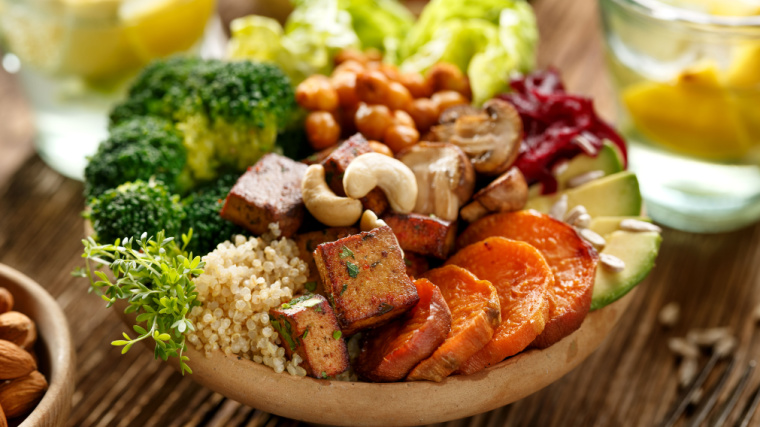
[Read More: The 12 Best Greens Powders]
Dietitians recommend getting the bulk of your nutrients through food sources, but you can add supplements if you struggle to get enough protein. Making shakes with a high-quality vegan protein powder can help you boost your intake. Soy protein powder is a great choice. It’s a complete protein source and contains all the essential amino acids you need to build muscle.
The Best High-Protein Vegetables
You may be used to having veggies as a side dish or salad, but they can also be the main event. Here are the best high-protein vegetables to boost your nutrient intake or support a vegan diet.
The nutritional information for these veggies comes from the FoodData Central feature on the United States Department of Agriculture (USDA) website. (12)
- Edamame
- Lentils
- Black Beans
- Chickpeas
- Mung Beans
- Lima Beans
- Green Peas
- Quinoa
- Wild Rice
- Sweet Corn
- Cooked Spinach
- Artichokes
- Collard Greens
- Brussels Sprouts
- Sweet Potato
Edamame
Edamame beans are a type of soybean from the legumes family. Edamame is one of the most protein-rich vegetables you can eat. They also contain vitamin K and folate and are a great source of healthy carbs.
One cup of edamame contains 18.5 grams of protein, 12 grams of fat, and 13.8 grams of carbohydrates.
Lentils
Lentils are also from the legume family. Some consider them a superfood because they are so nutrient-dense. They contain B vitamins, magnesium, potassium, and phosphorus. They’re a great source of protein and also high in fiber.
One cup of lentils yields 17.9 grams of protein, 0.8 grams of fat, and 39.9 grams of carbs.
Black Beans
Black beans are versatile and a great addition to a stir-fry. They contain antioxidants to boost your immune system and fiber to keep you full.
A one-cup serving of black beans has 15 grams of protein, one gram of fat, and 41 grams of carbs.
Chickpeas
Chickpeas, or garbanzo beans, are a nutty legume and the main ingredient in hummus and falafel. Chickpeas contain fiber, protein, B vitamins, and folate.
One cup of chickpeas yields 14.5 grams of protein, four grams of fat, and 45 grams of carbs.
Mung Beans
Mung beans are another superfood to add to your diet. They’re high in all of the essential amino acids that you need to build muscle. Mung beans also contain potassium, magnesium, phosphorus, and other antioxidants that may help lower blood pressure and cholesterol.
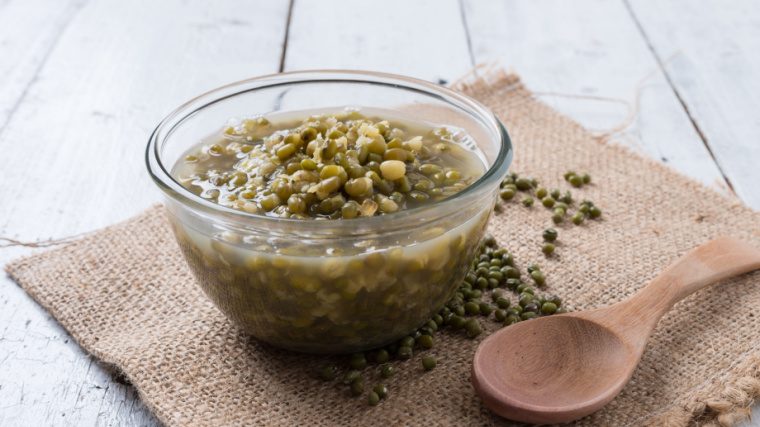
A one-cup serving of mung beans has 14.2 grams of protein, 0.8 grams of fat, and 38.8 grams of carbs.
Lima Beans
Lima beans are next on our list — another nutrient-dense legume that is a good vegan protein source. They’re also high in magnesium and potassium. You can get creative with recipes by combining multiple beans for a stir-fry or stew.
One cup of lima beans packs 11.6 grams of protein, 0.5 grams of fat, and 40 grams of carbs.
Green Peas
Forget about green peas as a boring side dish when you were a kid, and add them to your muscle-building veggie list. Green peas are also a great source of vitamin A and vitamin K.
A one-cup serving of green peas contains 8.58 grams of protein, 0.4 grams of fat, and 25 grams of carbs.
Quinoa
Quinoa is a whole grain that’s also a protein source. It’s an excellent base for a stir-fry, and you can add other high-protein vegetables. Quinoa is nutrient-dense. It contains antioxidants, folate, zinc, and fiber.
One cup of cooked quinoa has 8.1 grams of protein, 3.5 grams of fat, and 39.4 grams of carbs.
Wild Rice
Surprisingly, wild rice is not rice, but it makes a great addition to boost the protein content of a rice-based dish. Wild rice is a grain that contains potassium, iron, and plant-based protein.
A one-cup serving of wild rice contains 6.54 grams of protein, 0.5 grams of fat, and 34.9 carbs.
Sweet Corn
Sweet corn is a delicious summertime high-protein vegetable loaded with antioxidants.
One cup of sweet corn contains 5.4 grams of protein, 2.1 grams of fat, and 41 grams of carbs.
Cooked Spinach
As we move into the leafy green portion of the list, the protein content gets a little lower. However, leafy green vegetables like spinach are high in other micronutrients. Add them to your dishes that contain higher protein sources. Spinach contains vitamin A, iron, and fiber.
One cup of cooked spinach yields 5.35 grams of protein, 0.5 grams of fat, and 6.8 grams of carbs.
Artichokes
Artichokes are rich in micronutrients like vitamin C, folate, magnesium, potassium, and phosphorus. They also contain fiber and other antioxidants.
A one-cup serving of artichokes packs 5.0 grams of protein, 0.6 grams of fat, and 20 grams of carbs.
Collard Greens
Collard greens are rich in multiple vitamins and minerals. They’re a great source of calcium, folate, vitamin A, vitamin C, and vitamin K. They also contain fiber and antioxidants.
One cup of collard greens contains 4.21 grams of protein, 0.8 grams of fat, and 7.5 grams of carbs.
Brussels Sprouts
Brussels sprouts contain vitamin C and vitamin K. They’re a great addition to a dish with other high-protein vegetables.
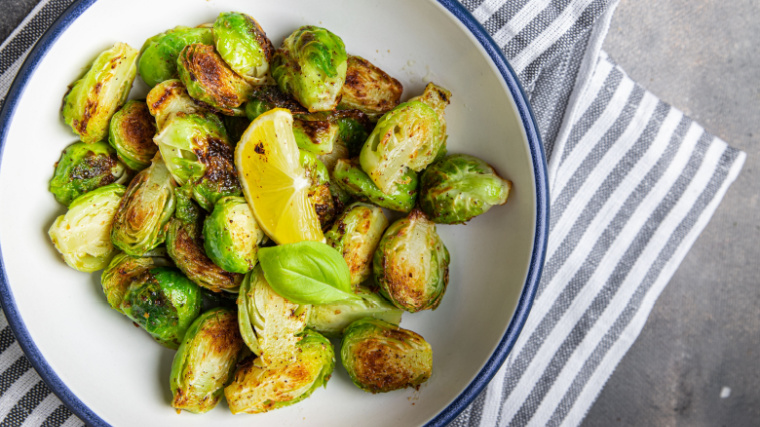
One cup of Brussels sprouts contains 4.0 grams of protein, 0.8 grams of fat, and 11 grams of carbs.
Sweet Potato
Sweet potatoes are a great source of healthy carbs and energy; some people like to have them as part of a pre-workout meal. They also make a great addition to a stir-fry or stew with other high-protein vegetables. Sweet potatoes contain vitamin A and vitamin C. They’re a great source of beta-carotene, a health-boosting antioxidant.
[Read More: What’s the Best Time to Drink Your Pre-Workout Mix?]
A one-cup serving of sweet potato yields 4.0 grams of protein, 0.3 grams of fat, and 41 grams of carbs.
How Much Protein Do You Need Daily?
Now that you know how much protein you can get from veggies, how much do you need daily?
As a minimum requirement for bodily functions, the Food and Drug Administration (FDA) recommends 50 grams of protein per day for adults. (13)
However, active people need more than 50 grams. The amount of protein you need may vary based on your body, age, activity level, and fitness goals.
Check out BarBend’s protein intake calculator to input your stats and get personalized protein needs.
Protein Intake Calculator
Age
Sex
Height
Weight
Goal
Activity Level
Do you know your body fat percentage?
[Read More: The 12 Best Supplements for Muscle Growth]
The American College of Sports Medicine (ACSM) gives a general recommendation for active people: 1.2 to 1.7 grams of protein per kilogram of body weight — or 0.5 to 0.8 grams per pound. (14)
If you’re trying to gain muscle or lose body fat, you may need more than that.
For Muscle Growth
Multiple studies have tried to nail down the perfect protein intake goal for building muscle. First, be sure that you are resistance training and eating enough calories.
The ACSM and the International Society of Sports Nutrition (ISSN) give slightly different recommendations.
- ACSM Guidelines: 1.6 grams of protein per kilogram of body weight is the minimum for building muscle, and anything over 2.2 grams may be unnecessary. (14)
- ISSN Guidelines: 1.4 to 2.0 grams of protein per kilogram of body weight for building and maintaining muscle mass. (15)
Competitive bodybuilders looking to pack on as much muscle mass as possible while doing a high volume of training may need even more. Research shows most bodybuilders can achieve their gains at 2.3 to 3.1 grams of protein per kilogram of body weight per day. (16)
- Putting it all together, someone looking to build muscle mass who isn’t competing should aim for 1.4 to 2.2 grams of protein per kilogram of body weight per day.
For Fat Loss
When trying to lose body fat, you want to keep your protein high while reducing your calories or portions to help your body preserve lean muscle. Resistance training is also key to the equation.
- To lose body fat while maintaining muscle, the ISSN recommends 2.3 to 3.1 grams of protein per kilogram of body weight per day. (15)
Veg Out
If you don’t want to eat animal products, you can still crush your goals through high-protein vegetables. Getting enough protein helps you build muscle, lose body fat, and improve your heart, bone, and immune health. Even if you still eat meat, incorporating plant-based protein into your diet can further boost your heart health.
That doesn’t mean you have to eat pounds of spinach after the gym to build your biceps. Choose from our list of the most protein-rich veggies and combine them into meals to reach your protein intake goals. Legumes, beans, peas, quinoa, wild rice, sweet corn, spinach, artichokes, collard greens, Brussels sprouts, and sweet potato all contain plant-based protein and other micronutrients to boost your health. Blend up a protein shake for even more.
Frequently Asked Questions
Here are some common questions and answers on high-protein foods.
Edamame is the vegetable with the highest protein, packing 18.5 grams of protein per one-cup serving.
The top sources of high-protein vegetables are edamame, legumes, beans, and quinoa. Tempeh and tofu are also high sources of plant-based protein.
References
- Carreiro AL, Dhillon J, Gordon S, Higgins KA, Jacobs AG, McArthur BM, Redan BW, Rivera RL, Schmidt LR, Mattes RD. The Macronutrients, Appetite, and Energy Intake. Annu Rev Nutr. 2016 Jul 17;36:73-103.
- Watford M, Wu G. Protein. Adv Nutr. 2018 Sep 1;9(5):651-653.
- Camera DM. Evaluating the Effects of Increased Protein Intake on Muscle Strength, Hypertrophy and Power Adaptations with Concurrent Training: A Narrative Review. Sports Med. 2022 Mar;52(3):441-461.
- Stokes T, Hector AJ, Morton RW, McGlory C, Phillips SM. Recent Perspectives Regarding the Role of Dietary Protein for the Promotion of Muscle Hypertrophy with Resistance Exercise Training. Nutrients. 2018 Feb 7;10(2):180.
- Paddon-Jones D, Westman E, Mattes RD, Wolfe RR, Astrup A, Westerterp-Plantenga M. Protein, weight management, and satiety. Am J Clin Nutr. 2008 May;87(5):1558S-1561S.
- Westerterp-Plantenga MS, Nieuwenhuizen A, Tomé D, Soenen S, Westerterp KR. Dietary protein, weight loss, and weight maintenance. Annu Rev Nutr. 2009;29:21-41.
- Hu FB. Protein, body weight, and cardiovascular health. Am J Clin Nutr. 2005 Jul;82(1 Suppl):242S-247S.
- Qi XX, Shen P. Associations of dietary protein intake with all-cause, cardiovascular disease, and cancer mortality: A systematic review and meta-analysis of cohort studies. Nutr Metab Cardiovasc Dis. 2020 Jun 25;30(7):1094-1105.
- Bonjour JP. Dietary protein: an essential nutrient for bone health. J Am Coll Nutr. 2005 Dec;24(6 Suppl):526S-36S.
- Li P, Yin YL, Li D, Kim SW, Wu G. Amino acids and immune function. Br J Nutr. 2007 Aug;98(2):237-52.
- Chandra RK. Nutrition and the immune system: an introduction. Am J Clin Nutr. 1997 Aug;66(2):460S-463S.
- USDA. FoodData Central. U.S. Department of Agriculture.
- USDA. Current dietary guidelines. Dietary Guidelines for Americans, 2020-2025.
- Rodriguez NR, DiMarco NM, Langley S; American Dietetic Association; Dietitians of Canada; American College of Sports Medicine: Nutrition and Athletic Performance. Position of the American Dietetic Association, Dietitians of Canada, and the American College of Sports Medicine: Nutrition and athletic performance. J Am Diet Assoc. 2009 Mar;109(3):509-27.
- Jäger R, Kerksick CM, Campbell BI, Cribb PJ, Wells SD, Skwiat TM, Purpura M, Ziegenfuss TN, Ferrando AA, Arent SM, Smith-Ryan AE, Stout JR, Arciero PJ, Ormsbee MJ, Taylor LW, Wilborn CD, Kalman DS, Kreider RB, Willoughby DS, Hoffman JR, Krzykowski JL, Antonio J. International Society of Sports Nutrition Position Stand: protein and exercise. J Int Soc Sports Nutr. 2017 Jun 20;14:20.
- Helms ER, Aragon AA, Fitschen PJ. Evidence-based recommendations for natural bodybuilding contest preparation: nutrition and supplementation. J Int Soc Sports Nutr. 2014 May 12;11:20.
Featured Image: marilyn barbone / Shutterstock
The post Add These High-Protein Vegetables to Your Diet for a Muscle-Building Boost appeared first on BarBend.
